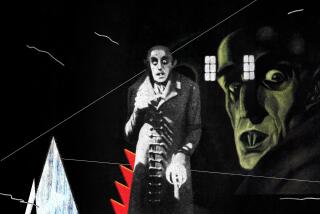‘Midsommar’s’ sound design creates a unique — and unsettling — sonic signature
Highly creative use of sound does much to plunge the viewer deep into the increasingly disoriented world of “Midsommar,” filmmaker Ari Aster’s slow-burning freakout about vacationing American students caught up in a Swedish commune’s sinister folk rituals. The story leads its emotionally traumatized heroine Dani (Florence Pugh) through a series of strange episodes whose surreal qualities resonate through sound design that is full of surprises.
“That was his main goal,” said Gene Park, the film’s Brooklyn-based supervising sound editor and re-recording mixer, “to really have it be a mind ...”
Park oversaw a team of about 20 to put together multiple brain-scrambling sequences, from an early, mood-setting psychedelic mushroom trip to a gruesome cliff-jumping ritual to a vertiginous dance around a maypole, which marks a decisive turn for Pugh’s character.
“None of us are necessarily horror guys,” said Park, whose career was built on work with a string of independent filmmakers, including Lena Dunham, with her 2010 debut “Tiny Furniture,” and Rick Alverson, most recently with this year’s “The Mountain.” Park also supervised sound on the 2019 releases “The Farewell” and “Bad Education.”
“We weren’t really into the tropes of horror, what’s often done for the standard horror film. That worked to our advantage … we were pretty conscious of trying to avoid conventions.”
Director Ari Aster’s attention to detail is a key pleasure of “Midsommar,” a darkly comic saga of Americans visiting a blissed-out, yet sinister, commune.
Instead, the sound department worked hard to give the film its own sonic signature, raising the ante wherever possible. “The team was really committed to not using old sounds but creating them from scratch,” Aster said. “Almost nothing was pulled from the library.”
One of the most effective approaches was the striking use of silence, and distortion, to shut down the outside world and emphasize interior sounds of Dani’s breathing at dramatic moments. After a shocking incident early in the film, the character reels in disbelief, suddenly disconnected from the world around her.
“Everything goes weird, muted out, muddy sounding,” Park said. “ We try to put the audience and Dani in a state of confusion. Some people have written me and said it really reminded them of when they first got the news of when one of their parents had died, this really intense stuff of how they weren’t really able to hear or focus on anything.”
Park was especially proud of a challenging set piece that comes as the story makes a decisive pivot. “Not to pull the curtains back, but the May Queen dance sequence took a lot of time,” he said, noting the extra effort involved in making the sound shift along with the movement on screen as Dani, hopped up on a mind-altering elixir, joins in the frenzied circular movement of the fateful competition.
“We wanted the score and some of the sound to go in circles with the camera work, but very specifically, so at points we went frame by frame,” he said of the scene, whose panning across the soundstage also would play very impressively on a pair of headphones, “and combining that with some of the peaks where her breathing gets tripped out and really loud.”
Throughout “Midsommar,” Park sought to blur divisions between the sound design and the spellbinding original score by Bobby Krlic (the British composer who performs as the Haxan Cloak). “They almost intertwine with each other,” he said, citing the visionary Russian filmmaker Andrei Tarkovsky (“Stalker”) who “thought of sound and score as the same thing.”
Such philosophy synchronized with Aster’s intentions. “There’s a lot of really beautiful orchestral music and a lot of symphonic pieces, but also a lot of subliminal noise that people might not be picking up on,” the director said. “That’s a huge part of turning the screws and keeping that white noise of doom running underneath the movie.”
His work on “Midsommar” brings Park full circle in a way. Thanks to a “real crazy six-degrees thing,” he got his start as part of the two-man sound crew on the Duplass brothers’ 2008 indie “Baghead,” which starred Greta Gerwig in a genre-ish relationship comedy that gradually drifts into horror. At the time, Park was the guitarist in a Williamsburg rock band alongside his friend Byron Westbrook, who had also played guitar in Jay and Mark Duplass’ group, Volcano, I’m Still Excited!
“They wanted to find a more economical way of doing sound,” Park said. The brothers first asked Westbrook, who brought along Park. “He’d never done it before, I’d never done it before, so it was us winging it, trying to figure out how to do it. ‘Baghead’ ended up playing Sundance, so it was a very fortunate way to get started.”
And, as it happened, a much more promising career option than guitar hero. “It was that period in the mid-aughts and there were a ton of indie bands. The National, Arcade Fire, the Strokes. They were the figureheads. I was part of that era,” Park said, adding with a laugh, “but I ended up in the graveyard of that era.”
More to Read
Only good movies
Get the Indie Focus newsletter, Mark Olsen's weekly guide to the world of cinema.
You may occasionally receive promotional content from the Los Angeles Times.










